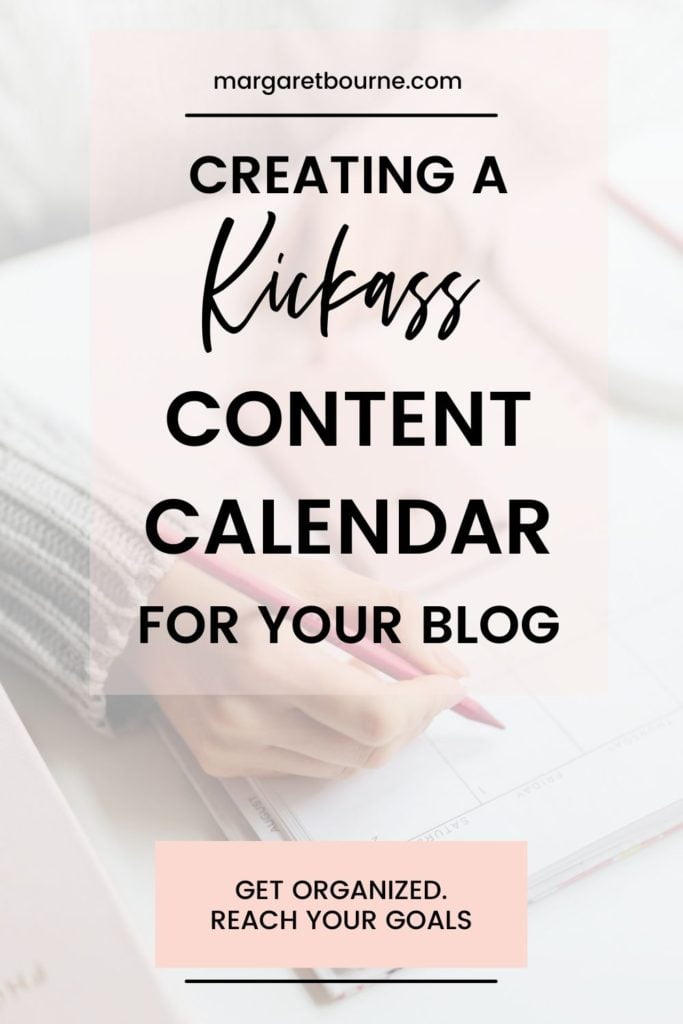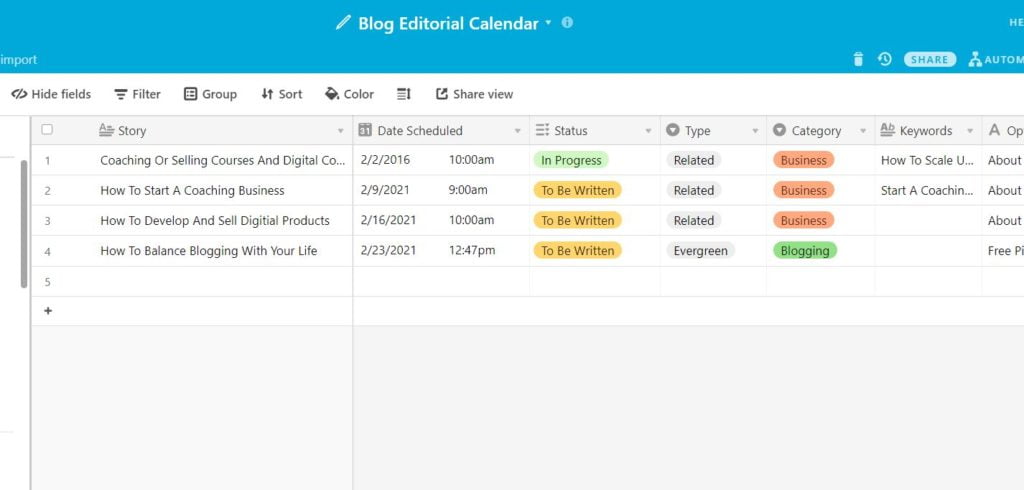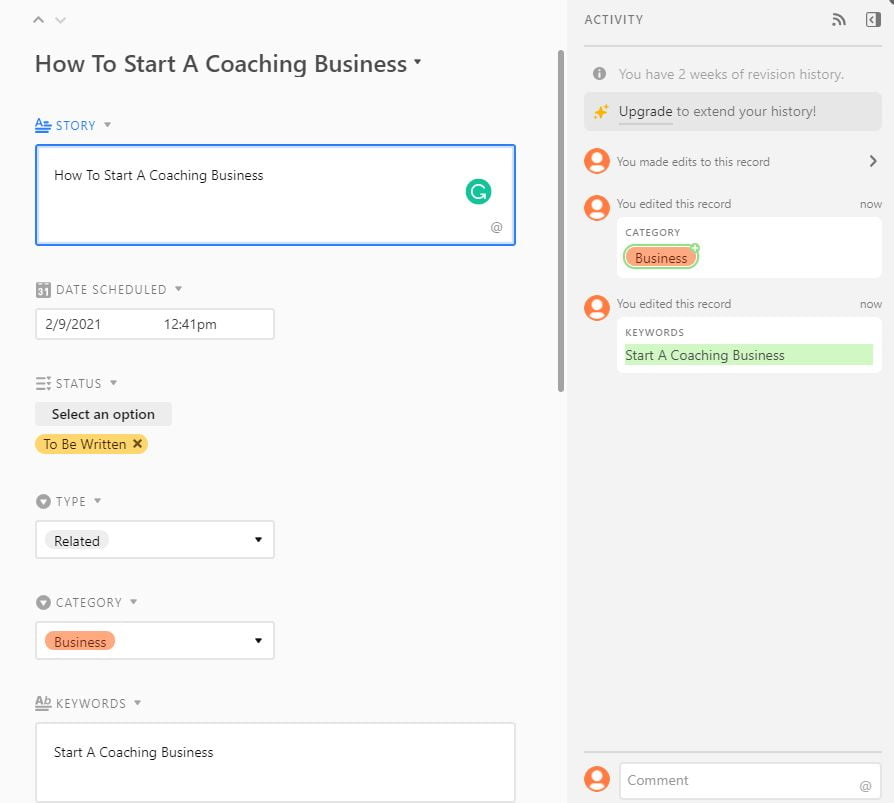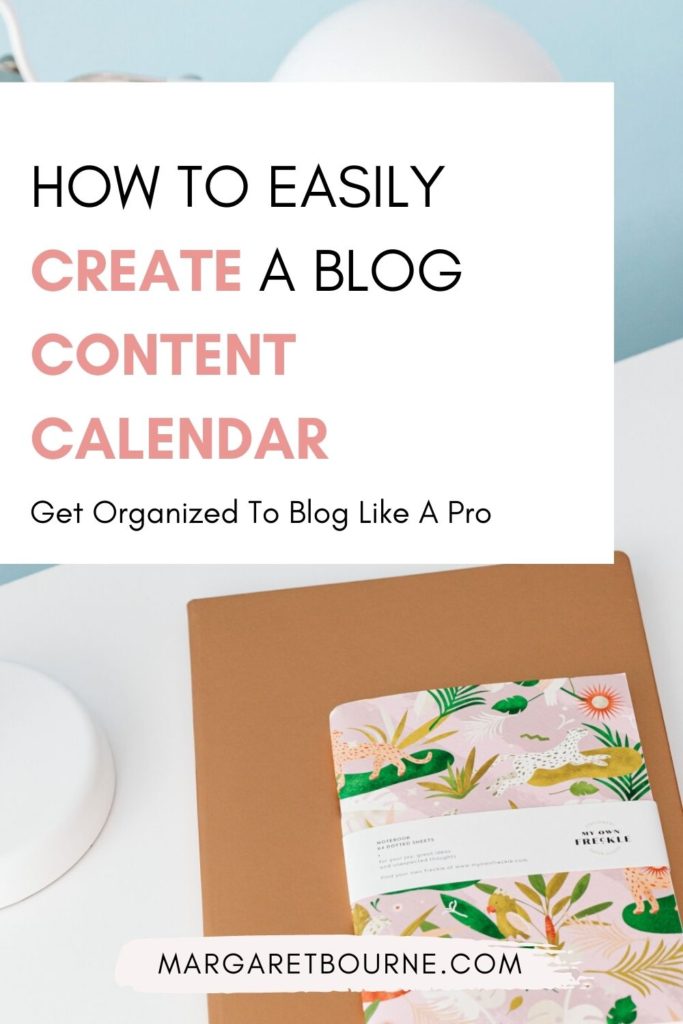Creating a list of blog post ideas is one of the best things a blogger should do at the beginning of the year. But you may be wondering how to create a blog content calendar that works for your needs and keeps you on track in 2025!
Also called a “blog editorial calendar”, it helps you plan your posts and programs, helping you keep your blog organized in the process.
It helps you build your blog schedule to keep consistently publishing fresh posts.
But you’re probably wondering how to create a content calendar for your blog. Where do you start?
If you’re committed to creating one post a week, you’ll be publishing 52 blog posts. That’s 52 post topics you need to brainstorm, and then organize into a content calendar.
It may seem overwhelming, but it’s quite doable if you stick to a monthly and weekly schedule.
The organizing part is easier in many cases. The brainstorming part is sometimes difficult. What do you write about and when?
Several factors affect blog topics and when you publish them.
In this post, we’ll explore some of these key questions that everybody has when starting to create a content calendar for a blog. You’ll find this useful for new content, and for updating old blog posts for SEO.

DISCLOSURE: This post contains affiliate links, meaning if you click on a product or service, and decide to purchase it, I may receive a commission at no extra cost to you. All recommended products and services are based on my positive experience with them. For more information, please read my Disclaimer.
Bookmark this post on Pinterest for future reference!

When Should You Start Planning Your Blog Content Calendar?
Before we jump into the nitty gritty of what goes into a blog content calendar and how to create one, let’s look at when you should start it.
If you’ve been blogging for a while, I recommend you start planning in early September.
Why?
It’s because you should publish your January posts no later than early October to get them ranking both on Google and Pinterest.
It can take up to a few months before your posts get ranked.
The second reason why September is the ideal time to start your blog content calendar is that it’s not the busy Holiday season.
In general, you’re less busy in September and October, so take advantage of quieter moments (and perhaps rainy days) to plan your blog editorial calendar.
Types Of Blog Posts Used For Creating A Blog Content Calendar
A content calendar for blog posts needs blog post topics!
Before you begin brainstorming your blog post ideas, consider these types that you should include in your content calendar:
- Seasonal blog posts
- Evergreen blog posts
- Cornerstone blog posts
- Announcement/news blog posts
You can also venture into other types of posts, including:
- Featured interview posts
- Podcast posts with summaries or transcripts
- Product review posts
All will be very useful for growing your blog traffic throughout the year.
| Related: Over 100 Lifestyle Blog Post Ideas
Seasonal Blog Posts For Your Blog Calendar
One of my favourite content calendar tips is to include timely, seasonal blog posts.
Personally, I get a huge bump up in ongoing traffic during each season if I have content that addresses things that are happening at that time.
Seasonal blog posts are those that are related to things like the Holiday period, the start of the seasons, and international and national holidays.
As you know, when they occur, you can populate your calendar with blog post topics at least 2 to 3 months BEFORE these events happen.
Why so early? It’s because you want Pinterest and search engines to properly index your pins/posts so they’re searchable before the specific event happens.
If your blog niche doesn’t work well with Christmas, Easter or other holidays, you can focus on just the season’s general activities. So, for example, if your blog is about hiking, you may want to focus on tips for Spring hikes or Spring gear.
Also, consider seasonal trends: losing weight and getting your finances in order in January, love in February, getting ready for Spring in March, etc.
PRO TIP: Use Google Trends and Pinterest Trends as research tools. Find out when certain topics are trending and plan on publishing posts 2 to 3 months in advance.
Evergreen Blog Content
Create a content calendar for blog posts by considering the blog types that will generate consistent traffic.
Evergreen blog posts are those with topics that you can include in your calendar at any time of the year.
These are topics you can plug into spots when you have nothing else that’s relevant or urgent.
I like to have at least 60% of my content be evergreen content, as it consistently brings in traffic.
Cornerstone Blog Content
Next on my list of content calendar tips is cornerstone content.
Cornerstone blog post content can be evergreen, but it’s bigger than that. It’s a key blog post from which related blog posts are linked.
Much like a pillar post, it’s often on a broad subject, and related blog posts are detailed posts on points raised in the cornerstone blog post.
For example:
- Cornerstone Blog Post topic: How To Start A Blog
- How To Set Up A WordPress Site
- How To Choose The Best Blog Theme For Your Blog
- How To Create A Blog Logo
- How To Start Your Email Newsletter List
When creating a content calendar for your blog, consider one or two cornerstone blog posts and all the related blog posts you can link to them.
Better yet, look at your blog’s main “parent” categories and ensure you have one cornerstone blog post per blog category.
You want cornerstone content because, with proper interlinking, you’ll keep site visitors on your blog longer as they peruse relevant posts.
Announcement/News Blog Posts
These types of blog posts work when you’re announcing the launch of a new program you’re offering, or if you’re part of a summit or event.
If you know you’re going to be launching something or part of an event, add some content before it to build up interest and excitement.
This works great to showcase the person behind the blog. It’s an opportunity to reveal more of what’s behind the scenes or to share your excitement for your work.
Related Reading:
Over 100 Lifestyle Blog Post Ideas For Beginners
75 Spring Blog Post Ideas For Lifestyle Blogs
100 Summer Blog Post Ideas For Lifestyle Blogs
Over 120 Fall Blog Post Ideas For Lifestyle Blogs
Winter Blog Post Ideas That Go Beyond The Holiday Season
How To Create A Blog Content Calendar
There are many ways you can create a blog content calendar.
I like to do a big brainstorming session for my blog post ideas first.
For brainstorming, I use a notepad or Google Sheets to write down all blog post ideas. Keep it simple at first to gather all your ideas!
The easiest are seasonal blog posts, so those can be brainstormed fairly quickly. Add them to your content calendar at least two to three months before the event date or start of the season.
The second batch that I work on is cornerstone posts, with related posts. For these, I try to publish them close to each other, so my readers keep coming back for more.
Then I look at general evergreen posts for questions that new bloggers regularly ask in Facebook groups.
Finally, I look at my overall goals for the year and tentatively book announcements/news blog posts or ones that will be perfect for launches. For example, if you know you’re going to be launching a new course for your readers in March, book it then.
Read More: Over 16 Types Of Blog Posts To Grow Your Blog
Add Opportunities For Blog Post Updates
When you’re creating your content calendar for your blog posts, consider the time you’ll also need to update existing posts.
Blog updates are a necessity when it comes to SEO and fresh information.
When you’re planning your weekly blogging activities, squeeze in an hour or two to update existing content. It’s already there, ready to drive more traffic with just a few tweaks.
Content Calendar Tips: Using AI To Help With Blog Post Idea Generation
If you’re stuck coming up with blog post ideas, turn to AI.
There are many fantastic tools to use for coming up with blog post ideas that you can research to see if they have high search volumes.
Here’s what you can use to generate blog post ideas:
- ChatGPT
- Rank IQ (also with SEO keywords search built-in)
- Writesonic – includes a free blog post ideas generation tool
Even Google itself is a smart place to search for blog content ideas. Look at the “People Also Ask” section.
Use A Monthly Planner To Organize Your Blog Calendar Posts
To make it easier to organize your blog posts, consider using a monthly planner.
You can use a paper planner or an online one. Whatever works for you!
I keep it simple. I make myself a template in Canva with four slots for four blog posts each month. With 12 sheets printed out, one for each month, I’m ready to begin planning.
This gives me one blog post a week. I like to use a pencil to write them out for the year. If I need to change something, I can do so easily.
I also take these notes and create a Google Sheets version. It acts as a checklist for each month, as well can also be easily used for other activities, like my monthly Pinterest schedule calendar.
| RELATED: 10 Tips For How To Keep A Blog Business Organized
Try Online Content Planners
You can create a blog content calendar using one of the many online project management tools available for free.
One free planner that I like to use for my blog calendar is Airtable. The free version is enough for most blogging needs, and you can create checklist planners for many different types of lists.
There is a good template for blog editorial calendars that you can use as a basis for your preferred version. It’s super-easy to customize.
It comes in different types of views, so if you like lists, grids or Kanban-style planners, it’s great. I personally like the calendar view for a quick overview of what I’m working on.

You can set a worksheet for a blog editorial calendar and fill out your blog post details. It’s a fantastic way to track your upcoming posts.
Entering your details and updating them is also super simple.

For anybody working with guest bloggers, it’s also very useful to keep track of who is writing what and the status of their work.
The best thing about Airtable is that it’s very easy to figure out how to customize your blog editorial calendar schedule to work with your needs.
You can use it on your desktop or via an iOS app. Although the free version is adequate enough for most people, if you’re making MANY lists, it’s fairly reasonable to upgrade to the next level (USD $6/month).
Try Airtable today – no charge to sign up for a free account.
And get FREE access to my content calendar template:
Blog Content Calendar Template
Using Google Sheets or Airtable, create a blog content calendar template for yourself.
My recommended headings are as follows:
- Blog Post Idea
- Notes (general notes you add to the content)
- Current Status (options can be “to be written”, “in progress”, “published”, “to be updated”)
- Scheduled Date
- Keywords
- Links
- An opt-in lead magnet (have a list of your lead magnets to choose from)
- Affiliate products (add notes as to which ones to include)
- Pinterest pin (check it off if you’ve created one)
- Facebook post
- Instagram posts
You can add more columns. For example, if you have regular guest post authors, you can add a column with the “Author”.
These are just the basics that will help you get started and keep you organized.
Get Started On Your Blog Content Calendar!
Now that you know how to create a blog content calendar, it’s time to get started!
Although sometimes you’ll have blog post ideas pop up and you’ll want to write about them as soon as possible, in many cases, you’ll stick to your established content calendar.
Your content calendar will help you create your social media posts and do promotional activities as well.
As you get started planning, remember a few key points:
- Consider different types of content that will generate blog traffic
- Brainstorm your ideas and note them down
- Use a monthly planner to plan out the whole year – either in an electronic version or via a printed template
- Consider using a customizable online content planner like Airtable that keeps you super organized
Finally, get excited! If you’re organized and ready to go, you’re probably miles ahead of many other bloggers out there.
Just remember to avoid the temptation of copying the content from others. You can be inspired to write on the same topic, but make it your own.
Before you go, get my printable templates for organizing your blog post content and daily and weekly checklists.
QUESTION: If you have any additional tips on how to create a blog content calendar, I’d love to hear them!
Like this post? Share it on Pinterest!









Love these tips, and you made it easy to plan for the year.
GREAT! I love to hear this. Glad it could help you out.
Thanks for this article. I’ve been haphazardly blogging for about 5 years without a definitive niche (or at least a very broad one) and have never had a content calendar or posting consistency. I have tons of creative ideas but for some reason, I can’t organize myself and spreadsheet content calendars seem to overwhelm me to the point I end up shutting down. Weird, I know!
I like the ideas of the paper and pencil method but you mention both that and Airtable. Do you actually use both?
Thanks for any help and motivation you can offer me.
Paula
http://www.dimplesonmywhat.com
Hey Paula – I can be like you, writing on the fly at times, but also trying to stick to a schedule. One trick you may want to use is to look at your categories, and see which ones need some blog posts, in comparison to your others. From there, brainstorm or organize the blog post ideas under these categories. Create a schedule to have one post a month for the categories lacking in blog posts.
I use both a notebook and then I transfer over ideas to Airtable. I try to do this regularly, as I inevitably have notes in several notebooks, on my phone, scraps of paper. It’s good to consolidate into one place and then tackle each post! Airtable also helps you figure out which categories need some more content.
I honestly didn’t realize I should be planning a year ahead of schedule. I had been operating a month ahead and posting everything on the day it was happening. It makes a lot of sense that the platforms need time to find me. Thanks for making that so logical. I am checking out Airtable now.
You could do it monthly but it’s more advantageous to plan ahead!
I love your “evergreen” posts – they’re always insightful. 🙂
The Seasonal Blog Posts For my Calendar is very helpful,great tips I learn today by just reading your blog post!
Downloaded your printables. I feel like when I actually have time to sit down and work on my blog I don’t know where to put my focus! I do a bit here and a bit there. This might help me stay on task!
Let me know if they help, or if I should add any other sections for notes!